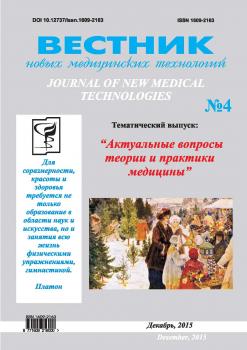The frequency of the Cesarean section leads to increase number of the patients with the scar on the uterus. In the Clinical hospital № 1 (Smolensk, Russia) the childbirth is carried out through natural birth canal on the women having a reliable scar on the uterus. The analysis of the vaginal delivery and labour outcomes in 69 patients with the scar on the uterus is carried out. The childbirth in 38 patients was conducted with the epidurals, in 31 patients – without this type of anesthesia. The efficiency and safety of the epidural anesthesia are shown. The obtained results confirm that the epidural anesthesia doesn´t complicate the labour, doesn´t increase the hospitalization term, doesn´t influence the bleeding and negative effects on the fetus condition and the newborn assessment according to Apgar score. The possibility of using epidural anesthesia at childbirth on the women with uterine scar during the dystocia is shown.
birth, the scar on the uterus, epidural analgesia
1. Aleksandrovich Yu.S., Gordeev V.I. Otsenoch-nye i prognosticheskie shkaly v meditsine kritiche-skikh sostoyaniy. SPb.: ELBI, 2010. 203 s.
2. Gustovarova T.A. Beremennost´ i rody u zhenshchin s rubtsom na matke (kliniko-morfologicheskie i diagnosticheskie aspekty). Diss.d-ra med.nauk. M., 2007. 330 s.
3. Kireev S.S., Matveev A.F. Anesteziologicheskoe posobie u zhenshchin pri preryvanii beremennosti. Vestnik novykh meditsinskikh tekhnologiy. Elektronnoe izdanie. 2013. №1. Publikatsiya 2-10. URL: http://www.medtsu.tula.ru/VNMT/Bulletin/E2013-1/4226.pdf (data obrashcheniya: 01.02.2013).
4. Kireev S.S., Matveev A.F., Aleshina A.A. Vybor optimal´nogo vnutrivennogo anestetika v «ginekologii odnogo dnya». Vestnik novykh meditsinskikh tekhnologiy. 2013. T. 20. №1. S. 74-75
5. Kireev S.S., Matveev A.F., Trukhina T.N., Serova N.T. Vybor anesteziologicheskogo posobiya pri traditsionnykh i laparoskopicheskikh Operatsiyakh v ginekologii. Vestnik novykh meditsinskikh tekhnologiy. 2010. T. 17. №1. S. 61-62.
6. Lantsev E.A., Abramchenko V.V. Anesteziya, intensivnaya terapiya i reanimatsiya v akusherstve. Moskva: MEDpress-inform, 2010. 581 s.
7. Ovechkin A.M. Sovremennye mestnye anestetiki - farmakologiya i bezopasnost´. Materialy 4 Vserossiyskoy konferentsii «Kriticheskie sostoyaniya v akusherstve i neonatologii». Petrozavodsk, 2006. S. 716-726.
8. Rozentul I.G., Kabylbekov A.K., Kutuzov R.I. Nekotorye prakticheskie aspekty epidural´noy analgezii v akusherstve. Materialy 3 Vserossiyskogo obrazovatel´nogo kongressa «Anesteziya i reanimatsiya v akusherstve i neonotologii». M., 2010. S. 101-104.
9. Basic E., Basic-Cetkovic V., Kozaric H., Rama A. Ultrasound evaluation of uterine scar after cesarean section. Acta Inform Med. 2012. 20. 3. R.149-153.
10. Genç Moralar D, Aygen Türkmen U, Altan A, Arısoy R, Tahaoğlu E, Ozakın E. The comparison of epidural continuous infusion and epidural patient controlled bolus administration in laboranalgesia. Agri. 2013. 25(1). R. 19-26.
11. Hawkins JL. Epidural analgesia for Labour and delivery. N Engl J Med. 2010. 362. R. 1503-1510.
12. Lederman P., Lederman G., Work B.A., Mc.Cann D.S. The relationship of maternal anxiety, plasma catecholamine and plasma cortisol to progress in labor. Am J Obstet Gynec. 1978. V. 132. №5. R. 495-500.
13. Li Q, Li CX, Liu Y, Xue WN, Chen TM. Influ-ence of epidural ropivacaine in combination with fen-tanyl for labor analgesia on the clinical outcome of labor. Nan Fang Yi Ke Da Xue Xue Bao. 2008. V. 28. №6. R. 1070.
14. Pugliese PL, Cinnella G, Raimondo P, De Ca-praris A, Salatto P, Sforza D, Menga R, D´Ambrosio A, Fede RN, D´Onofrio C, Consoletti L, Malvasi A, Brizzi A,Dambrosio M. Implementation of epidural analgesia for labor: is the standard of effec-tive analgesia reachable in all women? An audit of two years. Eur Rev Med Pharmacol Sci. 2013. 17(9). R. 1262-1268.
15. Reynolds F., Sharma S.K., Seed P.T. «Analgesia in labour and fetal acid - base balance: a meta - analysis comparing epidural with systemic opioid analgesia». BJOG. 2002. 109. R. 1344-1353.
16. Sia A.T. A comparison of a basal infusion with automated mandatory boluses in parturient-controlled epidural analgesia during labor. Anesth.Analg. 2007. V. 104. №3. R. 673-678.
17. Wang LZ, Chang XY, Liu X, Hu XX, Tang BL. Comparison of bupivacaine, ropivacaine and levobupi-vacaine with sufentanil for patient-controlledepidural analgesia during labor. A rando-mized clinical trial. 2010. 123(2). R. 178-83.
18. Ware L.J. Evaluation of the revised faces pain scale, verbal description scale, numeric rating scale, and Iova pain thermometer in older minority adults. Pain Management Nursing. 2006. 7.R. 117-125.
19. Winkelman C, Norman D, Maloni JA, Kless JR. Pain measurement during labor: comparing the visual analog scale with dermatome assessment. Appl Nurs Res. 2008. 21(2). R. 104-109.
20. Wong C.A. Advances in labor analgesia. Int J Womens Health. 2010. 1. R. 139-154.





